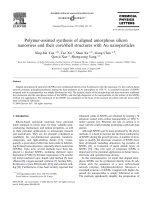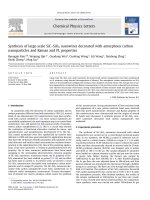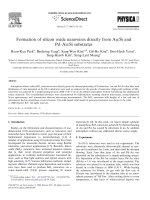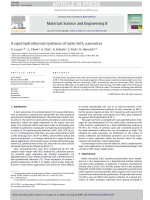- Trang chủ >>
- Khoa Học Tự Nhiên >>
- Vật lý
synthesis of bundled tungsten oxide nanowires with controllable morphology
Bạn đang xem bản rút gọn của tài liệu. Xem và tải ngay bản đầy đủ của tài liệu tại đây (351.42 KB, 4 trang )
Synthesis of bundled tungsten oxide nanowires with
controllable morphology
Shibin Sun
a,b,
⁎
, Zengda Zou
a
, Guanghui Min
a
a
School of Materials Science and Engineering, Shandong University, Jinan 250061, China
b
Nanotubes Laboratory, Advanced Materials Research Group, School of Mechanical, Materials and Manufacturing Engineering,
the University of Nottingham, Nottingham NG7 2RD, UK
ARTICLE DATA ABSTRACT
Article history:
Received 18 September 2008
Received in revised form
12 November 2008
Accepted 12 November 2008
Bundled tungsten oxide nanowires with controllable morphology were synthesized by a
simple solvothermal method with tun gsten hexachloride (WCl
6
) as precursor and
cyclohexanol as solvent. The as-synthesized products were systematically characterized
by using scanning electron microscopy, X -ray diffraction and transition electron
microscopy. Brunauer–Emmett–Teller gas-sorption measurements were also employed.
Accompanied by an apparent drop of specific surface area from 151 m
2
g
− 1
for the longer
nanowires synthesized using a lower concentration of WCl
6
to 106 m
2
g
− 1
for the shorter
nanowires synthesized using a higher concentration of WCl
6
, a dramatically morphological
evolution was also observed. With increasing concentration of tungsten hexachloride (WCl
6
)
in cyclohexanol, the nanostructured bundles became larger, shorter and straighter, and
finally a block-shape product occurred.
© 2008 Elsevier Inc. All rights reserved.
Keywords:
Tungsten oxide nanowires
Solvothermal
Brunauer–Emmett–Teller
1. Introduction
One-dimensional (1− D) nanostructured materials, such as
nanorods, nanowires and nanotubes have attracted tremen-
dous attention owing to their unique physical, chemical and
optical properties [1–3]. Among them, tungsten oxides WO
x
(x=2–3)areofmuchimportanceduetotheirpotential
application in electrochromic display, semiconductor gas
sensors and photocatalysts [4–6]. Particularly, 1-D W
18
O
49
nanomaterials which exhibit unusual structural defects have
received special attention in recent years [7]. Following the
first synthesis of W
18
O
49
nanowires by breaking the mircro-
trees, a variety of techniques including thermal treatments,
vapor phase growth, etc have been employed in the produc-
tion of W
18
O
49
nanostructures, and their structure and
property characterizations have also been investigated thor-
oughly [8–10]. Nonetheless, most of the synthetic methods
involved high temperature or complicated procedures, mak-
ing them difficult for production in large quantity. Thus, wet
chemical methods, which are relative simple and promising in
large-scale production, need to be further developed.
Very recently, W
18
O
49
nanowires have been successfully
synthesized by soft-chemistry methods with WCl
6
or W (CO)
6
as the main precursor in different solvents that are usually
alcohol, water and cyclohexanol [11, 12]. Following this facile
route, we have reported the successful synthesis of ultra-thin
bundled tungsten oxide nanowires via a solvothermal
method. In addition, the morphology and phase transforma-
tion behaviour of the ultra-thin bundled nanowires under
thermal processing were also characterized in detail [13].In
this paper, further expanding from our previous work, we
demonstrate the synthesis of bundled tungsten oxide nano-
wires with various morphologies by simply changing the
concentration of tungsten chloride (WCl
6
) in cyclohexanol.
The as-synthesized bundles were systematically character-
ized and influences of the morphology on their specific
MATERIALS CHARACTERIZATION 60 (2009) 437– 440
⁎ Corresponding author. School of Materials Science and Engineering, Shandong University, Jinan 250061, China. Tel.: +86 531 88396145;
fax: +86 531 82616431.
E-mail address: (S. Sun).
1044-5803/$ – see front matter © 2008 Elsevier Inc. All rights reserved.
doi:10.1016/j.matchar.2008.11.009
surface areas were also investigated. Possible mechanisms
were proposed.
2. Experimental
Typically, WCl
6
was dissolved in 2 ml of ethanol in a beaker to
obtain a solution. Cyclohexanol was then added to the
solution, which was subsequently transferred to and sealed
in a PTFE-line 120 ml autoclave. The concentration of WCl
6
in
cyclohexanol varied from 0.003M to 0.007M in our experi-
ments. The autoclave was heated in a furnace at 200 °C for 6 h,
to realize the synthesis. After thorough washing with water,
ethanol and acetone several times, the centrifuged products
were used for further examination.
The structure, morphology and phase composition of the
as-synthesized products were then characterized by using a
scanning electron microscope (SEM, Philips XL 30, operated at
20 kV) equipped with energy-dispersive X-ray spectroscopy
(EDX), a X-ray diffractometer (XRD, Siemens D500, Cu radia-
tion) and a transmission electron microscope (TEM, JEOL
2000FX, 200 kV). Selected area electron diffraction (SAED)
investigation was also performed during the TEM experiment.
Brunauer–Emmett–Teller (BET) gas-sorption measurements
were conducted by using an Autosorb-1 sorptometer. The
surface area was calculated using the BET method based on
adsorption data in the partial pressure (P/P
o
) range 0.02–0.22,
and total pore volume was determined from the amount of
nitrogen adsorbed at P/P
o
=0.99.
3. Results and discussions
Fig. 1 shows SEM images of the as-synthesized products at
concentrations ranging from 0.003M to 0.007M. As shown in
Fig. 1a, the as-synthesized product at a concentration of
0.003M exhibits ultrathin features with length up to few
microns. Further TEM investigation can identify the bundled
feature, giving evidence that each 1-D nanostructured bundles
consist of nanowires with diameters of about 2-10 nm, as
shown in Fig. 2a. This bundled feature was often observed in
thin and long 1-D nanostructured materials due to their large
surface areas [14]. The SAED pattern (top left inset, Fig. 2b) of
the bundles exhibits broadened and strand spots, suggesting
that individual nanowires within the bundle all adopted the
same growth direction. This is a typical characteristic of
bundled 1-D nanostructured materials. Increasing the con-
centration to 0.004M, there is no evidence of major changes in
morphology except that the bundles become shorter. When
the concentration increased to 0.005M, apparent evolution can
be observed. As displayed in Fig. 1c, thicker and shorter
bundles with uniform size occurred, and they appeared to be
composed of small bundles. Fig. 2c is a corresponding TEM
image of the bundles synthesized at the concentration of
0.005 M. In comparison with the TEM image of the bundles
synthesized at the concentration of 0.003 M (Fig. 2a), major
change in the morphology can be seen. The diameter of the
bundles increased to about 150 nm and individual nanowires
cannot be discriminated. At a high concentration of 0.007 M,
the as-synthesized product exhibits block-like structure rather
Fig. 1– SEM images of bundled tungsten oxide nanowires synthesized at different concentrations of (a) 0.003 M, (b) 0.004 M,
(c) 0.005M and (d) 0.007 M. Inset in Fig. 1d is a high magnification image.
438 MATERIALS CHARACTERIZATION 60 (2009) 437– 440
than bundled feature. The irregular blocks are of about 8 μmin
length and 3 μm in diameter. By careful examination (inset in
Fig. 1d), it can be found that some bundles are randomly
distributed on the surface of these blocks.
XRD analysis was carried out to identify the crystalline
structure of the as-synthesized products. As shown in Fig. 3a,
the main diffraction peaks of the products synthesized at
concentrations of 0.003 M and 0.004 M match well with the
monoclinic W
18
O
49
phase (JCPDS No.71-2450). It should be noted
that the overall intensities of the diffraction spots are weak;
whilst the strongest peak intensity of (010) plane indicates that
the b010N is the dominant growth direction and that the close-
packed plane (010) is roughly perpendicular to the nanowire axis
in this monoclinic regime. The HRTEM image (Fig. 2b) indicates
that the lattice fringe separations are measured ca.0.38nmand
0.37 nm, respectively, which can be indexed as (010) and (103) of
monoclinic W
18
O
49
and in agreement with the election diffrac-
tion results (insetin Fig. 2b) [15]. At concentrationsof0.005M and
0.007M, some new peaks can be observed from the patterns of
the as-prepared products. We cannot identify the new peaks
exactly, buttheyarebelieved to correspondto WO
3 − x
because all
the as-synthesized products consist only of tungsten and
oxygen elements based on EDX results (Fig. 3b). However, t he
major peaks can still be assigned to W
18
O
49
with the strongest
intensity of (010) plane, indicating that the growth direction of
nanowires remained unchanged with increasing concentration.
It has been reported that the concentration of the
precursors greatly influences the morphology of the hydro-
thermal products [16]. The shape of a crystal is determined by
the difference in the relative growth rates of the individual
crystal planes and the resulting particles are anisotropic in
shape under certain supersaturation. In our work, at lower
precursor concentration, ultrathin and long bundles com-
posed of numbers of nanowires can be obtained, while larger
and shorter bundles or even block-shape products were
produced with increasing concentration. Here, we believe
that low solution concentration contributed to the lower
supersaturation of the tungsten source, promoting the growth
of tungsten oxide nanowires [11]. At higher concentration, the
highly saturated WCl
6
could prohibit the growth of tungsten
oxide nanowires along the b010N direction, leading to short
nanowires, and finally resulting in shorter and thicker bundles
due to agglomeration. As indicated in Fig. 2, the resulting
Fig. 3 – (a) XRD patterns of bundled tungsten oxide nanowires
synthesized at different concentrations ranging from 0.003 M
to 0.007 M. Peaks of monoclinic W
18
O
49
are marked by + and
Unassigned peaks are marked by *; (b) EDX profile of bundles
synthesized at concentration of 0.007M.
Fig. 2 – (a) TEM and (b) HRTEM images of bundled tungsten oxide nanowires synthesized at a concentration of 0.003 M; (c) TEM of
bundled tungsten oxide nanowires synthesized at a concentration of 0.005 M. Inset in Fig. 2b is the corresponding SAED
patterns of the bundled nanowires in Fig. 2a.
439MATERIALS CHARACTERIZATION 60 (2009) 437– 440
products synthesized at high concentrations are a mixture of
different types of WO
3 − x
. The formation of the tungsten oxide
mixture may be related to the oxygen content in the reaction
system. As the precursor concentration increases, the mole
fraction of oxygen decreases, which will inevitably lead to
oxygen vacancies in the as-synthesized tungsten oxides. In
addition, EDX result of the product prepared at concentration
of 0.007M indicates that the O/W atomic ratio is about 2.4
(Fig. 3b). Therefore, it is suggested that the as-synthesized
products at high concentration should be a mixture of W
18
O
49
(WO
2.72
) and WO
2
.
BET gas-sorption measurements were employed to evalu-
ate the specific surface area and porous featur es of the
bundled tungsten oxide nanowires. The calculated specific
surface area and pore volume of the longer bundles synthe-
sized using concentration of 0.003 M are 151 m
2
/g and 0.51 cc/g
[12], whilst the shorter bundles synthesized using concentra-
tion of 0.005 M are 106 m
2
/g and 0.21 cc/g, respectively. The
high specific surface area of the bundled nanowires can be
ascribed to a combination of the ultra-thin feature of
individual nanowires and the unique packing characteristic
of the bundles themselves. The high specific surface area is
also associated with the sizes and distributions of the pores,
which arise from the solvothermal process at low temperature
and inter-nanowire spaces with bundles [12]. The shorter and
thicker bundles will consequently lead to decreased pore
volumes (e.g. from 0.51 cc/g to 0.21 cc/g) with increasing
concentration, which in turn resulted in the decreased specific
surface area.
4. Conclusion
In summary, bundled tungsten oxide nanowires with con-
trollable morphology were prepared by a simple solvothermal
method with tungsten hexachloride (WCl
6
) as precursor and
cyclohexanol as solvent. With increasing concentration of
tungsten hexachloride (WCl
6
) in cyclohexanol, dramatically
morphological evolution can be observed. The bundles
became larger, shorter and straighter, and finally a block-
shape product occurred. The resulting longer tungsten oxide
bundles exhibit a high specific surface of 151 m
2
g
− 1
, which
decreased to 106 m
2
g
− 1
for shorter tungsten oxide bundles.
Acknowledgement
We thank the China Scholarship Council (CSC) of the Ministry
of Education for sponsoring the study of SBS in the UK, and the
EPSRC (UK) for financial support.
REFERENCES
[1] Lou XW, Zeng HC. An inorganic route for controlled synthesis
of W
18
O
49
nanorods and nanofibers in solution. Inorg Chem
2003;42:6169–71.
[2] Shen GZ, Bando Y, Golberg D, Zhou CG. Electron-beam-induced
synthesis and characterization of W
18
O
49
nanowires. J Phys
Chem C 2008;112:5856–9.
[3] Rothschild A, Sloan J, Tenne R. Growth of WS
2
nanotubes
phases. J Am Chem Soc 2000;122:5169–79.
[4] Baeck SH, Choi KS, Jaramillo TF, Stucky GD, McFarland EW.
Enhancement of photocatalytic and electrochromic properties
of electrochemically fabricated mesoporous WO
3
thin films.
Adv Mater 2003;15:1269–73.
[5] Santato C, Odziemkowski M, Ulmann M, Augustynskj J.
Crystallographically oriented Mesoporous WO
3
films: Synthesi s,
characterization, and applications. J Am Chem Soc
2001;123:10639–49.
[6] Solis J L, Saukko S, Kish L, Granqvist CG, Lantto V. Semiconductor
gassensorsbasedonnanostructuredtungstenoxide.ThinSolid
Films 2001;391:255–60.
[7] Li YB, Bando Y, Golberg D. Single-crystalline In
2
O
3
nanotubes
filled with In. Adv Mater 2003;15:581–5.
[8] Zhu YQ, Hu WB, Hsu WK, Terrones M, Grobert N, Hare JP.
Tungsten oxide tree-like structures. Chem Phys Lett
1999;309:327–34.
[9] Hong KQ, Xie MH, Wu HS. Tungsten oxide nanowires
synthesized by a catalyst-free method at low temperature.
Nanotech 2006;17:4830–3.
[10] Jeon S, Yong KJ. Direct synthesis of W
18
O
49
nanorods from
W2N film by thermal annealing. Nanotech 2007;18:245602.
[11] Choi HG, Jung YH, Kim DK. Solvothermal synthesis of
tungsten oxide nanorod/nanowire/nanosheet. J Am Ceram
Soc 2005;88:1684–6.
[12] Zhao YM, Hu WB, Xia YD, Smith EF, Zhu YQ, Dunnill CW.
Preparation and characterization of tungsten oxynitride
nanowires. J Mater Chem 2007;17:4436–40.
[13] Sun SB, Zhao YM, Xia YD, Zou ZD, Min GH, Zhu YQ. Bundl ed
tungsten oxide nanowires under thermal processing. Nanotech
2008;19:305709.
[14] Pfeifer J, Badal jan E, TekulaBuxbaum P, Kovacs T, Geszti O,
Toth AL. Growth and morphology of W
18
O
49
crystals produced
by microwave decomposition of ammonium paratungstate.
J Cryst Growth 1996;169:727–33.
[15] Yoo SJ, Lim JW, Sung YE, Jung YH, Choi HG, Kim DK. Fast
switchable electrochromic properties of tungsten oxide
nanowire bundles. Appl Phys Lett 2005;86:141901.
[16] Moon J, Carass o ML, Krarup HG, Kerchner JA, Adair JH.
Particle-shape control and formation mechanisms of
hydrothermally derived lead titanate. J Mater Res 1999;14:866–75.
440 MATERIALS CHARACTERIZATION 60 (2009) 437– 440









